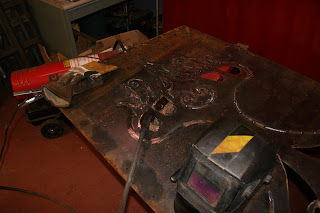In May of this year I was commissioned to create a sculptural installation for a brand new school building in Telford, Shropshire.
After an initial meeting with the client we decide to use the school's name of Woodlands as the central theme of the project, naturally this made native trees and plants a clear choice.
In terms of format I quickly came to the decision that a series of wall sculptures in the form of panels would be ideal. This was suggested by both the inviting large walls of the new building and the fact that the distinctive outlines of the leaves of many native tree species looked like they would work very well in silhouette.
As well as finding as many stock photographs as possible I felt it was important to really get a feel for how trees and leaves looked and felt in the flesh as it were, so I took a lot of walks, collecting specimens, taking photographs and just absorbing the forms and textures of natural woodland. This quickly lead to a whole series of sketches as I gradually refined and developed my ideas.I was looking particularly for leaf and branch shapes which had distinctive and characterful silhouettes and shapes.
With this decision made and ideas for the design and compositional elements well under way, the next task was to consider the practical engineering implications of the content. I decide that rectangular panels with designs in relief and negative silhouette would be ideal. This approach would allow me to cut out the intricate and delicate designs that the forms of the leaves I was studying suggested while keeping a structure which was still robust, durable and, above all, safe.
Rather than simply bolt the flat panels to the walls I wanted to use a fixing method which would give a bit more depth and contrast to the wall. By spacing out the panels on steel frames I gave myself a lot more flexibility with the design and construction of the mechanical fixings without worrying about their visual impact and keeping the whole thing looking clean and refined. Spacing the panels out from the walls would also be an effective way to use shadow to emphasise the leaf shapes that I wanted to use.
I also realised that I wanted to create a dramatic centrepiece which would really sum up the mood of the whole installation and act as a focal point for the whole project. The obvious answer was to use the image of a single tree. After playing with several ideas I ended up with something which was quite stylised but still had a really organic feel and added an extra dimension to the more naturalistic renderings of the leaves.
I eventually came up with the design below. It went through quite a long process of evolution right up to the point when I was transferring the stencil onto the steel plate ready to be cut out. One thing I was particularly keen to get right was the sense of proportion. As is was such a large panel (1m x 2m) I wanted it to have some sense of upward movement to give a feeling of growth and not end up being too squat or heavy.





























